Music retail…will you miss it?
 By Susan Whitall – From her Blog at DetNews.com
By Susan Whitall – From her Blog at DetNews.com
Everybody has a different memory, when it comes to buying music at a bricks and mortar store, and the closing of the Virgin mega store in New York, one of two Virgin mega stores left in the U.S. (the other, in Hollywood, is also about to close) has led to many folks exchanging their favorite retail memories like Scott did here on Keener13.com.
 I can’t say any one chain had a hold on my heart; I remember pining for and finally convincing my mother to buy Stevie Wonder’s “Fingertips Part II,” the Motown single, at for me at the Kresge’s 5 & 10 in downtown Birmingham as a nipper. (The pic at left is a shot of the Downtown Kresge’s in the 60s – Curator) I wouldn’t have known what a record store was, back then.
I can’t say any one chain had a hold on my heart; I remember pining for and finally convincing my mother to buy Stevie Wonder’s “Fingertips Part II,” the Motown single, at for me at the Kresge’s 5 & 10 in downtown Birmingham as a nipper. (The pic at left is a shot of the Downtown Kresge’s in the 60s – Curator) I wouldn’t have known what a record store was, back then.
More often than not, I bought 45s and 33s at such places; I remember forking over $3 or so for Jimi Hendrix’s “Are You Experienced?” at Perry Drugs, to the elderly male cashier’s disdain. (“What are you going to torture your parents with now?” he said).
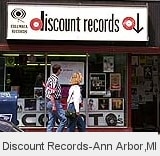 I do remember standing in line at Discount Records for a Beatles album, probably “Abbey Road.”
I do remember standing in line at Discount Records for a Beatles album, probably “Abbey Road.”
At Michigan State I once traded in a few textbooks for a copy of the Beatles’ White Album, an unexplained gap in my Beatles collection. It was a lucky break for me that the Student Bookstore carried records…
My favorite record store for years was the late, lamented Sam’s Jams in Ferndale, because it carried the more unusual stuff. I remember finding “Gino is a Coward” and some other vintage R&B, racked as oldies, at Sam’s. Never would you find anything that different at the chain stores. Today my only music retail stop is Street Corner Records at 13 and Southfield. (I hear they’re moving to Greenfield Plaza in Oak Park, but at least they’re still alive.) What’s your music retail favorite, or memory?
(June 20, 2009)
I forgot to mention E.J. Korvettes, a defunct discount emporium here in Michigan, as another place where I would top up my album collection. As a staffer at Creem Magazine in the ’70s I usually didn’t need to buy much, but I remember getting a slew of Jeff Beck albums there for about $3.00 each.
This was before the advent of $18 CDs pretty much destroyed the business model.
Most intriguingly, blogger (and keener13.com fan) Chris Morton of Floydian Slips,who also grew up near Birmingham, Mich., jump-started my memory bank when he mentioned a tiny drugstore on the northeast corner of Maple & Woodward Ave. in Birmingham. On the southeast corner sat Cunningham’s Drugstore, where I don’t recall buying any records, just music and fashion magazines.
Eureka! In the basement of this place on the NE corner (which I believe was called AAA Discount Drugs, although Chris isn’t so sure), in a dank little basement was a wonderland packed with 100s of 45s and 33s. As kids we would go down a narrow stairway and paw through the latest hits under garish lighting.
If anyone can help us with the name of this place that started so many on the road to music retail ruin, please do tell.
Susan Whitall writes about music, books, pop culture, radio and more for The Detroit News. You can reach her at swhitall@detnews.com.
Classic Ventures
the Ventures remain the most popular instrumental act of all time and one of the most popular bands ever in Japan. They charted five times on Keener with tunes like “Slaughter on 10th Avenue”, “Secret Agent Man”, “Fugitive” and the classics “Walk, Don’t Run” and “Hawaii Five-0”.
Many consider them a surf-rock band, but their music predated the genre and they never defined themselves as such.
When one of the founding members, Bob Bogle, passed away this week, we broke out “Walk, Don’t Run” and “Hawaii Five-0” and turned up the volume. Here’s video from their 2008 induction into the Rock n Roll Hall of Fame.
Closing of the last mega buggy whip store
By Scott Westerman
 “The closing of the last mega buggy whip store”. That’s the header of an email we received from our good friend John Kajander about the final days of the Virgin’s Mega-store in NYC. He included this link to Ben Sisario’s NYT story about the demise of the retail record business.
“The closing of the last mega buggy whip store”. That’s the header of an email we received from our good friend John Kajander about the final days of the Virgin’s Mega-store in NYC. He included this link to Ben Sisario’s NYT story about the demise of the retail record business.
We all remember buying our black vinyl at Harmony House, E.J. Korvettes, Hudsons and Discount Records back in the day. And more than one Keenerfan has written us over the years wondering if the decline of the record industry truly began when CDs marginalized the power of album art.
When LPs ruled the world, artists were defined and sometimes diminished by how they branded themselves on their album covers. Here are a few of our faves.
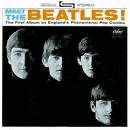 Meet The Beatles:
Meet The Beatles:
The quintessential debut album from the 60s. Often imitated in family photos, too. I remember seeing something almost identical with four members of a family in black and white. Capitol gutted the EMI British release to be able to create a US-only Second Album and the tracks included both Beatle originals and standards (remember Paul singing “Till There Was You” from the Music Man?) In our neighborhood, one of the boys holding a cigarette (on the back of the album) was a scandal.
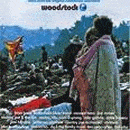 Woodstock
Woodstock
Perhaps the first double LP that many of us bought. Those who were there say that the cover gave a good vibe for the mixture of emotional highs and lows associated with the concert that got out of hand. The album, and the film made superstars out of then lesser known acts like Sha-Na-Na and Richie Havens and elevated Joe Cocker, Ten Years After and Santana to new heights. In the “what were they thinking” department, the managers for Creedence Clearwater Revival and the Grateful Dead refused to let their clients appear in the film. It wasn’t until this year that their footage, along with performance by Mountain and Johnny Winter found eyeballs on the blu-ray DVD edition.
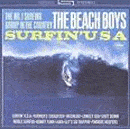 The Beach Boys – Surfin USA
The Beach Boys – Surfin USA
Growing up in Detroit, many of us had never seen one of those trademark 20 footers. The album photograph made it look much, much bigger. This record holds the distinction of being the first Beach Boys LP released in Stereo, although Brian Wilson didn’t participate in the original stereo mix downs. Chuck Britz, a Capitol records engineer, did the work. Prior Beach Boys collections were released in mono and something called Duophonic, where the voices were in one channel and the instrumentation in another. The late CD collections feature much better stereo mixes that give a feel for the full depth of Brian’s genius.
 Pink Floyd – Dark Side of the Moon
Pink Floyd – Dark Side of the Moon
The prism itself became the group’s trademark and the album went on to be one of the longest running Hot 100 LPs in Billboard history. Dark Side of the Moon was a one of those LPs that we used to let track all the way through during homework, to augment the effect of the mind-bending chemistry of the day, or as we tried our best to consummate our current romantic intentions. Whatever radio station you listened to in the early 70s probably used the instrumental vamp from “Breath” as the bed for whatever contest they were promoting at the time. Chicago radio fans will well remember it as the background for WCFL’s “Last Contest.”
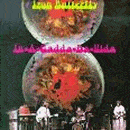 Iron Butterfly – In-A-Gadda-Da-Vida
Iron Butterfly – In-A-Gadda-Da-Vida
Every drummer who came of age in the 60s remembers Ron Bushy’s drum solo displacing “Wipe Out” as the definition of percussive chops. The story goes that the title was keyboard player Doug Ingle’s alcoholic mispronunciation of “In The Garden of Eden”. That’s a 17 year old former violin prodigy Erik Bann breaking psychedelic ground on guitar. Along with Led Zeppelin’s “Stairway to Heaven” and Elton John’s “Funeral for a Friend”, In-A-Gadda-Da-Vida was a DJ favorite, whenever we needed an uninterrupted 17 minutes to catch up on our homework.
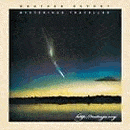 Weather Report – Mysterious Traveler
Weather Report – Mysterious Traveler
Back when I was at Michigan State University, we had a poster of this album cover in the lobby of our student radio station. I had never heard of Weather Report, but that poster alone made me want to buy the LP.
Times change. The paradigm of how to earn a living as a musical artist is more about merchandising and concertizing than it is about selling CDs and LPs. And there’s an interesting postscript to this inevitable evolution. If you kept your record collection in good condition, you might just be able to sell your albums on EBay.. as art, something that could end up in a frame in someone’s living room.
Comments:
Andru Reeve at 4:44pm June 15 on Facebook
Thankfully, we still have two great chains out here — Amoeba and Rasputin’s. Both operate under a different business model than Virgin and Tower did, so I think they’ll both be in business for awhile; they’re both always packed with customers who BUY stuff. Both stores sell an abundance of used product — CDs, DVDs, LPs. They appeal to both the music novice and the heavy collector. They don’t price things at LIST PRICE the way the two defunct chains did. Deep, deep discounts on new CDs. Also, they have web presence and, I believe, MP3 sales. Both chains have HUGE inventories, too. But … perhaps the most important thing is LOCATION; the stores all tend to be in population hubs that service up to a million folks. The stores are near busy highways and NOT in malls.
Scott Hanley at 5:24pm June 15 on Facebook
Hard to fit much artwork on a thumb drive…nice memories, Scott. And what of all those green sleeve 45’s for those of us in the radio biz….
Laura Smigielski Garcia at 7:02pm June 15 on Facebook
Do you remember when Peaches opened in Dearborn in mid 70s? That was the COOLEST record store ever. The lines to get in went clear around the bldg when they opened. Now we just have to be happy with itunes, I guess.
Dale Leslie at 9:03pm June 15 on Facebook
Personally, I preferred the Liberty Music Shop in Ann Arbor whose owner made a sensible decision when he relocated: he moved two blocks east on Liberty Street. Such atmosphere: the year-around screen door; the Gulf no-pest strips; the clerk whose breath was so putrid, the kids tipped her over on Halloween and remember?, every album jacket was empty (no kidding) because they stored the vinyl originals behind the cash-out counter. Brilliant!
Gary Mescher at 820pm June 16
You just had to drag me down memory lane at this late hour. Interesting insights as usual. I recall the Weather Report poster for the Heavy Weather album tacked on a wall in one of the WMSN studios around 1974. I still have all my college albums – having sold my baseball cards in 1980 (for $400) I am NOT going to see these memories from college days. I suspect there is some validity to the speculation that the down sizing of album art via the introduction of CD music technology did something to speed the demise of the album.
Chris Morton on June 17
We started buying LPs in the basement of B’hams’ Cunningham Drugs until Discount Records appeared in town. Soon a couple of us rabid (sic) collectors were buying a mix of LPs by the box, getting an additional discount for volume purchasing. Ten-plus years later, I looked forward to a yearly visit to Sam’s Jams, again spending hours and hours and buying boxes of LPs. Today all of that, and much, much more, sits on my media server. But yeah, I sure do miss the art!
First Look: Rock Band – Beatle Edition
In case you don’t have a gamer in the house, Rock Band is still one of the hottest video games in town. And it was only a matter of time until Apple (Records) came on the scene with a Beatle version. It hits the stores on 09/09/09. We’ve played the game with the kids and have had trouble identifying with some of the newer music. This should be MUCH more fun!
The Faygo Kid
We received some nice feedback from a Keenerfan who calls himself “The Faygo Kid”. Remember this?
Who were those guys??
 Who the heck was John R? How did the Lodge Freeway get its name? Who was Joseph Campeau? Keener Correspondent Eileen Trombley Glick, perhaps the most ardent cheerleader for the Motor City during its glory years, points us to the HistoryDetroit.com‘s fascinating page detailing the origin of Detroit’s streets.
Who the heck was John R? How did the Lodge Freeway get its name? Who was Joseph Campeau? Keener Correspondent Eileen Trombley Glick, perhaps the most ardent cheerleader for the Motor City during its glory years, points us to the HistoryDetroit.com‘s fascinating page detailing the origin of Detroit’s streets.
Eileen’s superb website, DetroitMemories.com should be on your favorites list.
BTW. John R. was a farmer, John C. Lodge was a Detroit mayor and Joseph Campeau was Detroit’s earliest real estate promoter.
How Keener Rated in 1965
By Scott Westerman
 From the Legend page at keener13.com: “..for WKNR, it was the right time, the right elements and the right place, and for an all-too-brief period it was Camelot.”
From the Legend page at keener13.com: “..for WKNR, it was the right time, the right elements and the right place, and for an all-too-brief period it was Camelot.”
Whenever I see the distinctive red, white and green logo from Bob Green Productions on a package, I know I’m in for a treat. In the seven years since keener13.com was born, Bob has been the project’s biggest cheerleader and contributor.
Once such gem arrived in my mailbox last week. It was a qualitative breakdown of the radio listening habits in Detroit during December and January of 1964-65.
This was the height of WKNR’s popularity. All the formatic details had been polished. And the on-air line-up that would be remembered as the quintessential Keener team was finding its center. In short, if you had to take a snapshot of WKNR at her best, this was the time.
The company that did the research was Pulse, a New York based radio research firm that specialized in face to face data gathering techniques that took interviewers door to door across Wayne, Oakland and Macomb counties. Then, as now, a microcosm of the overall audience was surveyed, just 1,034 households, with the results impressed across a broader universe to determine listening habits.
What stands out is Keener’s dominance as an advertising medium, regularly delivering listener ratings in the upper 20s and low 30s across just about every demographic dissection. Some factoids:
27.3% of all households surveyed listened to WKNR.
42.6% of three car households listened to WKNR.
3 in 10 Ford owners listened to Keener.
6 in 10 Rambler owners listened to Keener.
Department store shoppers preferred WKNR in droves.
46% of those surveyed had Federals charge accounts.
50% of those surveyed had charge accounts at E.J. Korvettes.
WKNR had a 20 share or higher across almost all occupational categories, ranking particularly high in executive and union-based professions.
WKNR had significant market share across all income demographics, playing particularly well at the upper end of the spectrum. 36.2% of those making the equivalent of $200,000 dollars a year were Keener listeners.
Our readers who are still in the radio business today would kill for 1/4 of these numbers.
And what a difference a decade makes. Ten years earlier (1955) was the decline of radio’s golden age. There was still long form programming across many day parts and Television had started its inexorable march to prominence with radio listenership spiraling downward.
Ten years later WKNR was history.
 Link: Pulse Detroit Qualitative 1 December 1964-January 1965 (53mb PDF – Pretty big file!)
Link: Pulse Detroit Qualitative 1 December 1964-January 1965 (53mb PDF – Pretty big file!)
Detroit Memories: Swingin Time on DVD, Detroit Birthdays & More
 By Eileen Trombley Glick
By Eileen Trombley Glick
Keener Correspondent at DetroitMemories.com
Swingin Time on DVD!
 Over the years, a number of folks have written to me asking about the Swingin’ Time shows. As luck would have it, L.A. resident Dave Fisher, Cass Tech ’63, who was a ‘regular’ on Swingin’ Time, taped six shows back then and has now burned them to DVD. They are dated:8-27-66, 9-3-66, 9-10-66, 9-17-66, 12-24-66 and 3-11-67. If you’re interested in these DVDs, contact me and I’ll send you a PDF of the artists who appeared on each of these shows along with information on how the DVDs can be viewed.
Over the years, a number of folks have written to me asking about the Swingin’ Time shows. As luck would have it, L.A. resident Dave Fisher, Cass Tech ’63, who was a ‘regular’ on Swingin’ Time, taped six shows back then and has now burned them to DVD. They are dated:8-27-66, 9-3-66, 9-10-66, 9-17-66, 12-24-66 and 3-11-67. If you’re interested in these DVDs, contact me and I’ll send you a PDF of the artists who appeared on each of these shows along with information on how the DVDs can be viewed.
Happy 50th Art Van and Little Caesars!
Art Van Elslander started working in a furniture store as a young man, and his entrepreneurial spirit led him to open his own store on Gratiot Avenue and 10 Mile Road in 1959. Despite the fact that Detroit’s economy was struggling during this time, Van Elslander was able to build his business, and between 1959 and 1964, he took on three business partners and opened seven more stores. Though the company experienced growth for some years, hard times hit Art Van Furniture in 1964. Getting creative, Van Elslander held a liquidation sale at the Michigan State Fair Grounds. He was able to sell everything and save the company. 1973, Art Van Furniture moved headquarters from the12 Mile Road and Van Dyke location to 14 Mile Road and Mound, where it is still located today. Art Van is the largest furniture retailer in Michigan, and the only independent family-run furniture store of its kind in the Midwest.
Mary Francis Masson Free Press Business Reporter writes:
A big “thank you, thank you” was bestowed on the couple who made “Pizza! Pizza!” a catchphrase. At a 50th anniversary celebration of Little Caesars, the kudos came from employees, franchisees, elected officials and even celebrities like Kid Rock, Eminem (who once worked at Little Caesars) and former President George W. Bush. Mike and Marian Ilitch opened their first Little Caesars restaurant in Garden City on May 8, 1959. Now there are about 2,500 Little Caesars pizza outlets located on five continents and in every U.S. state.
From the mailbag: I’m 67 years old and grew up in Detroit. I moved to Texas in 1960. When I was a little boy we lived on Detroit’s east side and my father would take me to an amusement park at 8 Mile Rd and Gratiot. I was wondering if anyone remembers the name of that park and if there are any surviving photos of the park? Also, are there any photos of Jefferson Amusement Park and is it still open? – Doug McLeroy Houston, Texas
Eastwood Park (aka Eastwood Gardens) was open from 1925-1953 and located at 8 Mile & Gratiot. It was a popular destination, helped by the fact that the streetcars turned around there. The park was a creation of Cyril Wagner, the same gentleman who opened Electric Park. In fact, Eastwood’s roller coaster came from Electric after it closed in the ’20s. Jefferson Beach was mostly destroyed by fire and closed in 1959. It boasted a 1,000 foot high roller coaster and a swimming beach. Additional information, memories and photos available at this terrific website: www.WaterWinterWonderland.com.
On a personal note, my dad was working at Jefferson Beach in 1947 when he met my mom, a visitor to the park. They married four months later and were together for 33 happy years. Our family lived about one mile from JB, so we went there often.
TV Talk with DETROIT TV GUY ED GOLICK Webmaster of www.DetroitKidShow.com and a vintage Detroit TV show expert
QUESTION: I was born in Ferndale in 1928. I studied at the Society of Arts & Crafts located on Watson street in Detroit, beginning in 1948. I have some good memories of ol’ Detroit. I remember Ralph Binge’s Beautiful Carl, Sharp Frank and, I believe there was one other character who were figments of Ralph’s comical imagination. He performed the voices. They were hilarious. They were very popular on his morning radio program, which was, I think, WXYZ, and the year was 1952. Can you give me more information about this show? – Bob Johnston Pawleys Island SC
ED SEZ: You can read more about Ralph Bingey and Joe Gentile on my website at http://www.detroitkidshow.com/Binge_and_Gentile.htm
Whatever happened to??
QUESTION: What ever happened to Don Zee? He was the midnight DJ at WXYZ. I listened to him all the time and even went down to the studio in Southfield with a friend of mine to visit with him one evening.
Art Vuolo, Radio’s Best Friend and Detroit broadcasting expert answers: Sadly, Don was killed in a gun accident while living in west Texas back in the late 1970s. Don “Daddy Zee” Oke (“Daddy Zee, two e’s, if you please”) worked the graveyard shift from midnight until 6 am, and always signed on with Dracula (Bobby Pickett), Elvira, and “Trantula” by The Trantulas.
Detroit Memories On YouTube: Check out Sonny Eliot’s 50th ANNIVERSARY INTERVIEW with Michael Collins from 1997.
Upcoming Class Reunions
Detroit St. Thomas – All years | St. Ambrose – All classes | Detroit Redford – Class of ’59 | Walled Lake Central – Class of ’59 | Mother Of Our Savior – 60’s Grade School Reunion | Highland Park – Class of ’64 | Waterford Kettering – Classes of ’64 and ’65 | Waterford Township – Class of ’68 | East Catholic – Class of ’69 | Lakeview (St. Clair Shores) – Class of ’69 | Livonia Franklin – Class of ’69 | Southfield – Class of ’69 | St. Florian – Class of ’69 | St. Mary Mt. Clemens – Class of ’69 | Waterford Kettering – Class of ’69 | Wyandotte Roosevelt – Class of ’69 | Madison – Class of ’74 | Clintondale – Class of ’77 | Lincoln Park – Class Of ’78 | Airport (Carleton, MI) – Class of ’79 | St. Clement – Class of ’79. Details on all Detroit area class reunions can be found here.
(Eileen Trombley Glick keeps Detroit Memories alive from her home base in Phoenix AZ. Click here to subscribe to the FREE Detroit Memories Newsletter.)
Internet Radio: Ready for Prime Time?
By Scott Westerman
 We noted with interest Saul Hansell’s NYT piece entitled “The Ascendance of Internet Radio“. In it, he showcases the pricey Tivoli wifi radio boxes. They are but one of a growing number of Internet appliances that play music. I say play music, because the definition of Internet radio doesn’t necessarily comply with how us Keenerfans might define the term.
We noted with interest Saul Hansell’s NYT piece entitled “The Ascendance of Internet Radio“. In it, he showcases the pricey Tivoli wifi radio boxes. They are but one of a growing number of Internet appliances that play music. I say play music, because the definition of Internet radio doesn’t necessarily comply with how us Keenerfans might define the term.
Services like Pandora and Rhapsody create playlists for you based on preferences you choose, playing your faves and interspersing them with stuff that the computer logic thinks you also might like. These services include applications that play on IPhones and wifi audio devices so you can take your playlists with you. Continue reading “Internet Radio: Ready for Prime Time?” →
WKNR’s Sgt. Pepper Connection
By Scott Westerman – Curator, Keener13.com
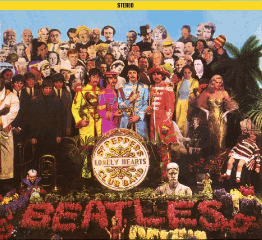 To paraphrase the Cannon, “It was 42 years ago today, Sgt. Pepper blew the world away..” On June 2, 1967 Sgt. Pepper’s Lonely Hearts Club Band was released in the United States. The collection ranks as number 1 on the Rolling Stone list of all-time great albums. its spawned a thousand imitators up to and including the Simpsons, and four decades later, the Beatles classic is still a household word. So why didn’t any of the album tracks ever make it to the WKNR Music Guide? What two Pepper session recordings weren’t included in the LP, but made it to number 2 on Keener before being included in The Magical Mystery Tour? Who ARE all of those people on the album cover? Which Pepper track did Russ Gibb study during his quest to solve the Paul McCartney death mystery? And what role did a famous WKNR personality play in promoting Sgt. Pepper’s release nationwide? Continue reading “WKNR’s Sgt. Pepper Connection” →
To paraphrase the Cannon, “It was 42 years ago today, Sgt. Pepper blew the world away..” On June 2, 1967 Sgt. Pepper’s Lonely Hearts Club Band was released in the United States. The collection ranks as number 1 on the Rolling Stone list of all-time great albums. its spawned a thousand imitators up to and including the Simpsons, and four decades later, the Beatles classic is still a household word. So why didn’t any of the album tracks ever make it to the WKNR Music Guide? What two Pepper session recordings weren’t included in the LP, but made it to number 2 on Keener before being included in The Magical Mystery Tour? Who ARE all of those people on the album cover? Which Pepper track did Russ Gibb study during his quest to solve the Paul McCartney death mystery? And what role did a famous WKNR personality play in promoting Sgt. Pepper’s release nationwide? Continue reading “WKNR’s Sgt. Pepper Connection” →
Primal Fogerty
By Scott Westerman

When I read Susan Whitall’s piece on John Fogerty, it brought back vivid memories of putting on the headphones in my Ann Arbor basement, stepping behind my Ludwigs and playing along with Creedence.
CCR charted 13 times on WKNR over a three year period between August of 1968 and July of 1971. The station played the hits, but also dug deeper into the albums, tracking secondary singles like Lodi, Commotion and Sweet Hitchhiker. With the exception of Suzi Q, every CCR appearance went top ten. Continue reading “Primal Fogerty” →
Can Muzak evolve and survive?
 Jeff Smith sent us this link to an NPR story about the past, present and questionable future of Muzak. For example, did you know that Lyndon Johnson owned a Muzak franchise and sold a subscription to the White House? Ken MacDonald, Sr., the erstwhile owner of radio stations in Saginaw, Cadillac and Petoskey once told me that a Muzak franchise was a “license to print money”. It may have subconsciously influenced my career direction.. I became a cable guy soon after that conversation.
Jeff Smith sent us this link to an NPR story about the past, present and questionable future of Muzak. For example, did you know that Lyndon Johnson owned a Muzak franchise and sold a subscription to the White House? Ken MacDonald, Sr., the erstwhile owner of radio stations in Saginaw, Cadillac and Petoskey once told me that a Muzak franchise was a “license to print money”. It may have subconsciously influenced my career direction.. I became a cable guy soon after that conversation.
Today Muzak is trying to dig their way out bankruptcy, even as some of the terrestrial broadcasters teeter on the brink. The key question: Will businesses pay for an “audio environment” in the age of the Ipod?
I remember sitting in the orthodontist’s office in Ann Arbor back in the 60s. Dr. Buatti had WLDM, “Detroit’s Foremost FM Station”, doing their Muzak impression in his waiting room. I wished I had a transistor with Keener playing in the ear piece. I think that perhaps that added to the excruciation of the whole braces experience!

